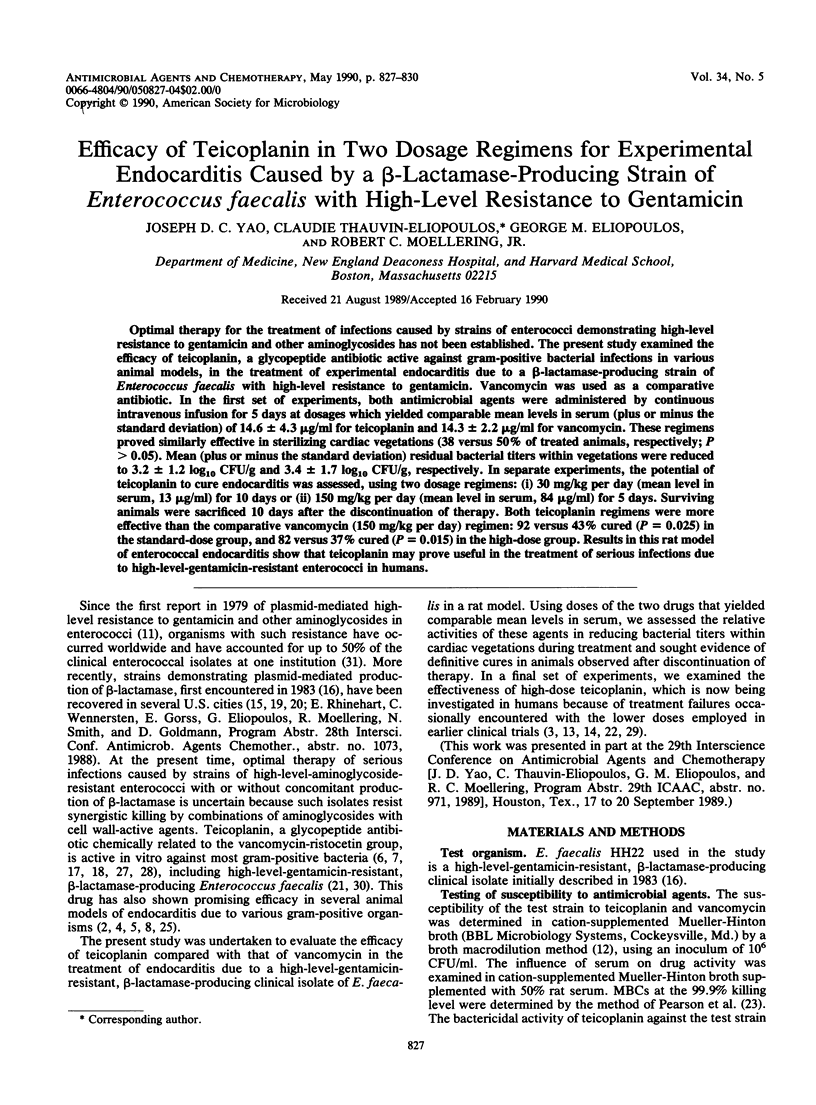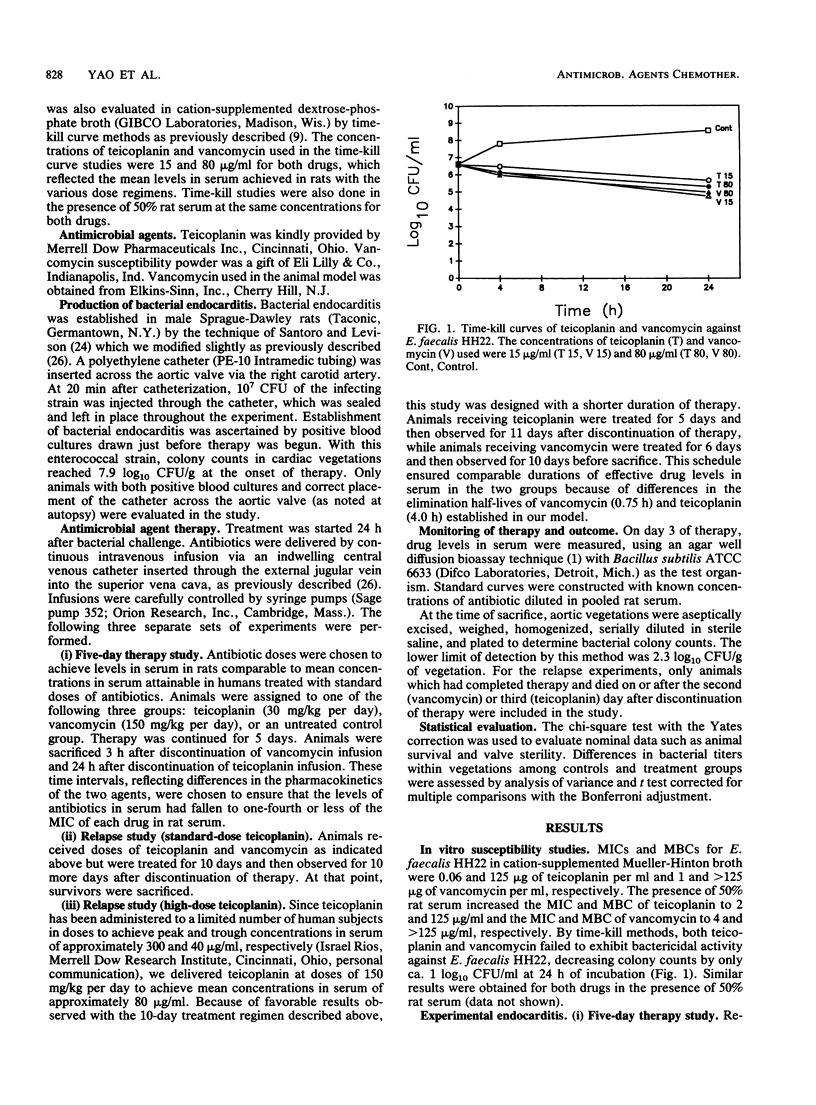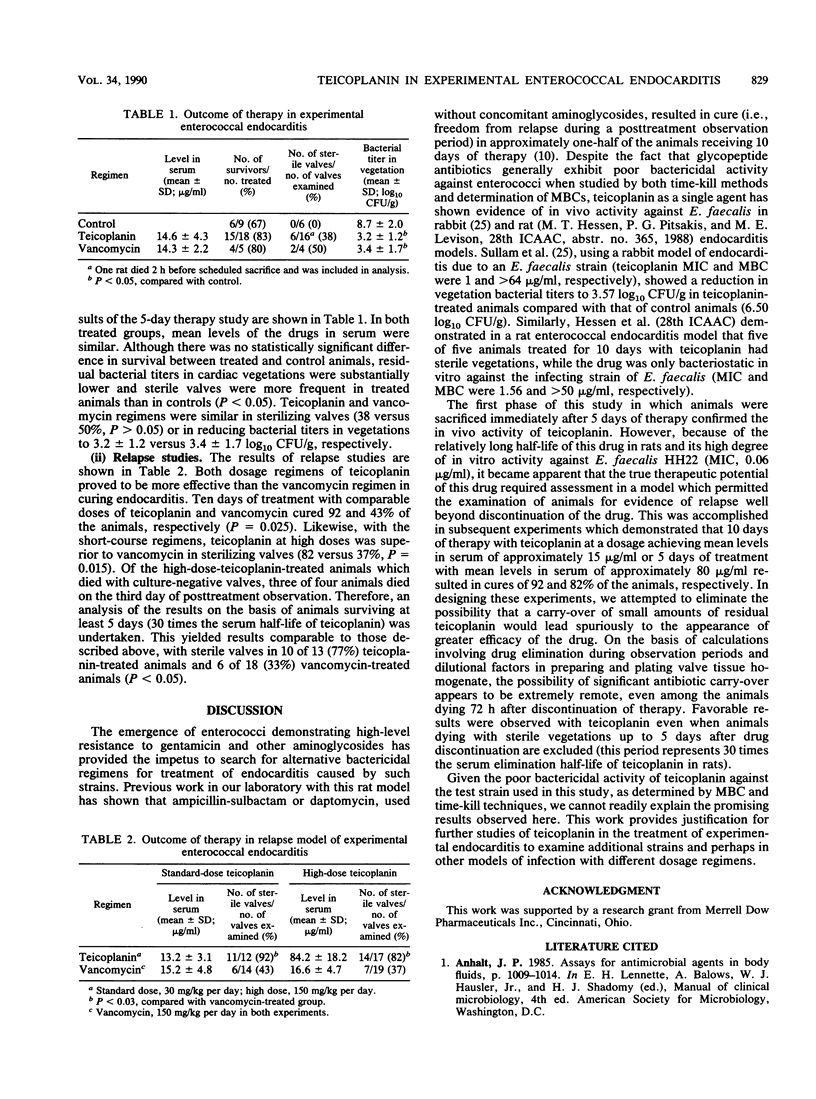Abstract
Optimal therapy for the treatment of infections caused by strains of enterococci demonstrating high-level resistance to gentamicin and other aminoglycosides has not been established. The present study examined the efficacy of teicoplanin, a glycopeptide antibiotic active against gram-positive bacterial infections in various animal models, in the treatment of experimental endocarditis due to a beta-lactamase-producing strain of Enterococcus faecalis with high-level resistance to gentamicin. Vancomycin was used as a comparative antibiotic. In the first set of experiments, both antimicrobial agents were administered by continuous intravenous infusion for 5 days at dosages which yielded comparable mean levels in serum (plus or minus the standard deviation) of 14.6 +/- 4.3 micrograms/ml for teicoplanin and 14.3 +/- 2.2 micrograms/ml for vancomycin. These regimens proved similarly effective in sterilizing cardiac vegetations (38 versus 50% of treated animals, respectively; P greater than 0.05). Mean (plus or minus the standard deviation) residual bacterial titers within vegetations were reduced to 3.2 +/- 1.2 log10 CFU/g and 3.4 +/- 1.7 log10 CFU/g, respectively. In separate experiments, the potential of teicoplanin to cure endocarditis was assessed, using two dosage regimens: (i) 30 mg/kg per day (mean level in serum, 13 micrograms/ml) for 10 days or (ii) 150 mg/kg per day (mean level in serum, 84 micrograms/ml) for 5 days. Surviving animals were sacrificed 10 days after the discontinuation of therapy. Both teicoplanin regimens were more effective than the comparative vancomycin (150 mg/kg per day) regimen: 92 versus 43% cured (P =0.025) in the standard-dose group, and 82 versus 37% cured (P = 0.015) in the high-dose group. Results in this rat model of enterococcal endocarditis show that teicoplanin may prove useful in the treatment of serious infections due to high level-gentamicin-resistant enterococci in humans.
Full text
PDF



Selected References
These references are in PubMed. This may not be the complete list of references from this article.
- Arioli V., Berti M., Candiani G. Activity of teicoplanin in localized experimental infections in rats. J Hosp Infect. 1986 Mar;7 (Suppl A):91–99. doi: 10.1016/0195-6701(86)90013-7. [DOI] [PubMed] [Google Scholar]
- Calain P., Krause K. H., Vaudaux P., Auckenthaler R., Lew D., Waldvogel F., Hirschel B. Early termination of a prospective, randomized trial comparing teicoplanin and flucloxacillin for treating severe staphylococcal infections. J Infect Dis. 1987 Feb;155(2):187–191. doi: 10.1093/infdis/155.2.187. [DOI] [PubMed] [Google Scholar]
- Chambers H. F., Sande M. A. Teicoplanin versus nafcillin and vancomycin in the treatment of experimental endocarditis caused by methicillin-susceptible or -resistant Staphylococcus aureus. Antimicrob Agents Chemother. 1984 Jul;26(1):61–64. doi: 10.1128/aac.26.1.61. [DOI] [PMC free article] [PubMed] [Google Scholar]
- Contrepois A., Joly V., Abel L., Pangon B., Vallois J. M., Carbon C. The pharmacokinetics and extravascular diffusion of teicoplanin in rabbits and comparative efficacy with vancomycin in an experimental endocarditis model. J Antimicrob Chemother. 1988 May;21(5):621–631. doi: 10.1093/jac/21.5.621. [DOI] [PubMed] [Google Scholar]
- Cynamon M. H., Granato P. A. Comparison of the in vitro activities of teichomycin A2 and vancomycin against staphylococci and enterococci. Antimicrob Agents Chemother. 1982 Mar;21(3):504–505. doi: 10.1128/aac.21.3.504. [DOI] [PMC free article] [PubMed] [Google Scholar]
- Fainstein V., LeBlanc B., Bodey G. P. Comparative in vitro study of teichomycin A2. Antimicrob Agents Chemother. 1983 Mar;23(3):497–499. doi: 10.1128/aac.23.3.497. [DOI] [PMC free article] [PubMed] [Google Scholar]
- Galetto D. W., Boscia J. A., Kobasa W. D., Kaye D. Teicoplanin compared with vancomycin for treatment of experimental endocarditis due to methicillin-resistant Staphylococcus epidermidis. J Infect Dis. 1986 Jul;154(1):69–75. doi: 10.1093/infdis/154.1.69. [DOI] [PubMed] [Google Scholar]
- Glew R. H., Millering R. S., Jr, Wennersten C. Comparative synergistic activity of nafcillin, oxacillin, and methicillin in combination with gentamicin against. Antimicrob Agents Chemother. 1975 Jun;7(6):828–832. doi: 10.1128/aac.7.6.828. [DOI] [PMC free article] [PubMed] [Google Scholar]
- Hindes R. G., Willey S. H., Eliopoulos G. M., Rice L. B., Eliopoulos C. T., Murray B. E., Moellering R. C., Jr Treatment of experimental endocarditis caused by a beta-lactamase-producing strain of Enterococcus faecalis with high-level resistance to gentamicin. Antimicrob Agents Chemother. 1989 Jul;33(7):1019–1022. doi: 10.1128/aac.33.7.1019. [DOI] [PMC free article] [PubMed] [Google Scholar]
- Horodniceanu T., Bougueleret L., El-Solh N., Bieth G., Delbos F. High-level, plasmid-borne resistance to gentamicin in Streptococcus faecalis subsp. zymogenes. Antimicrob Agents Chemother. 1979 Nov;16(5):686–689. doi: 10.1128/aac.16.5.686. [DOI] [PMC free article] [PubMed] [Google Scholar]
- Leport C., Perronne C., Massip P., Canton P., Leclercq P., Bernard E., Lutun P., Garaud J. J., Vilde J. L. Evaluation of teicoplanin for treatment of endocarditis caused by gram-positive cocci in 20 patients. Antimicrob Agents Chemother. 1989 Jun;33(6):871–876. doi: 10.1128/aac.33.6.871. [DOI] [PMC free article] [PubMed] [Google Scholar]
- Lewis P., Garaud J. J., Parenti F. A multicentre open clinical trial of teicoplanin in infections caused by gram-positive bacteria. J Antimicrob Chemother. 1988 Jan;21 (Suppl A):61–67. doi: 10.1093/jac/21.suppl_a.61. [DOI] [PubMed] [Google Scholar]
- Murray B. E., Church D. A., Wanger A., Zscheck K., Levison M. E., Ingerman M. J., Abrutyn E., Mederski-Samoraj B. Comparison of two beta-lactamase-producing strains of Streptococcus faecalis. Antimicrob Agents Chemother. 1986 Dec;30(6):861–864. doi: 10.1128/aac.30.6.861. [DOI] [PMC free article] [PubMed] [Google Scholar]
- Murray B. E., Mederski-Samaroj B. Transferable beta-lactamase. A new mechanism for in vitro penicillin resistance in Streptococcus faecalis. J Clin Invest. 1983 Sep;72(3):1168–1171. doi: 10.1172/JCI111042. [DOI] [PMC free article] [PubMed] [Google Scholar]
- Neu H. C., Labthavikul P. In vitro activity of teichomycin compared with those of other antibiotics. Antimicrob Agents Chemother. 1983 Sep;24(3):425–428. doi: 10.1128/aac.24.3.425. [DOI] [PMC free article] [PubMed] [Google Scholar]
- Pallanza R., Berti M., Goldstein B. P., Mapelli E., Randisi E., Scotti R., Arioli V. Teichomycin: in-vitro and in-vivo evaluation in comparison with other antibiotics. J Antimicrob Chemother. 1983 May;11(5):419–425. doi: 10.1093/jac/11.5.419. [DOI] [PubMed] [Google Scholar]
- Patterson J. E., Colodny S. M., Zervos M. J. Serious infection due to beta-lactamase-producing Streptococcus faecalis with high-level resistance to gentamicin. J Infect Dis. 1988 Nov;158(5):1144–1145. doi: 10.1093/infdis/158.5.1144. [DOI] [PubMed] [Google Scholar]
- Patterson J. E., Masecar B. L., Zervos M. J. Characterization and comparison of two penicillinase-producing strains of Streptococcus (Enterococcus) faecalis. Antimicrob Agents Chemother. 1988 Jan;32(1):122–124. doi: 10.1128/aac.32.1.122. [DOI] [PMC free article] [PubMed] [Google Scholar]
- Patterson J. E., Zervos M. J. Susceptibility and bactericidal activity studies of four beta-lactamase-producing enterococci. Antimicrob Agents Chemother. 1989 Feb;33(2):251–253. doi: 10.1128/aac.33.2.251. [DOI] [PMC free article] [PubMed] [Google Scholar]
- Pauluzzi S., Del Favero A., Menichetti F., Baratta E., Moretti V. M., Di Filippo P., Pasticci M. B., Guerciolini R., Patoia L., Frongillo R. F. Treatment of infections by staphylococci and other gram-positive bacteria with teicoplanin: an open study. J Antimicrob Chemother. 1987 Sep;20(3):431–438. doi: 10.1093/jac/20.3.431. [DOI] [PubMed] [Google Scholar]
- Pearson R. D., Steigbigel R. T., Davis H. T., Chapman S. W. Method of reliable determination of minimal lethal antibiotic concentrations. Antimicrob Agents Chemother. 1980 Nov;18(5):699–708. doi: 10.1128/aac.18.5.699. [DOI] [PMC free article] [PubMed] [Google Scholar]
- Santoro J., Levison M. E. Rat model of experimental endocarditis. Infect Immun. 1978 Mar;19(3):915–918. doi: 10.1128/iai.19.3.915-918.1978. [DOI] [PMC free article] [PubMed] [Google Scholar]
- Sullam P. M., Täuber M. G., Hackbarth C. J., Sande M. A. Therapeutic efficacy of teicoplanin in experimental enterococcal endocarditis. Antimicrob Agents Chemother. 1985 Jan;27(1):135–136. doi: 10.1128/aac.27.1.135. [DOI] [PMC free article] [PubMed] [Google Scholar]
- Thauvin C., Eliopoulos G. M., Willey S., Wennersten C., Moellering R. C., Jr Continuous-infusion ampicillin therapy of enterococcal endocarditis in rats. Antimicrob Agents Chemother. 1987 Feb;31(2):139–143. doi: 10.1128/aac.31.2.139. [DOI] [PMC free article] [PubMed] [Google Scholar]
- Varaldo P. E., Debbia E., Schito G. C. In vitro activity of teichomycin and vancomycin alone and in combination with rifampin. Antimicrob Agents Chemother. 1983 Mar;23(3):402–406. doi: 10.1128/aac.23.3.402. [DOI] [PMC free article] [PubMed] [Google Scholar]
- Verbist L., Tjandramaga B., Hendrickx B., Van Hecken A., Van Melle P., Verbesselt R., Verhaegen J., De Schepper P. J. In vitro activity and human pharmacokinetics of teicoplanin. Antimicrob Agents Chemother. 1984 Dec;26(6):881–886. doi: 10.1128/aac.26.6.881. [DOI] [PMC free article] [PubMed] [Google Scholar]
- Webster A., Wilson A. P., Williams A. H., Treasure T., Grüneberg R. N. The use of a new glycopeptide antibiotic, teicoplanin, in the treatment of bacterial endocarditis. Postgrad Med J. 1987 Aug;63(742):621–624. doi: 10.1136/pgmj.63.742.621. [DOI] [PMC free article] [PubMed] [Google Scholar]
- Yao J. D., Eliopoulos G. M., Moellering R. C., Jr In vitro activity of SK&F 104662, a new glycopeptide antibiotic. Antimicrob Agents Chemother. 1989 Jun;33(6):965–967. doi: 10.1128/aac.33.6.965. [DOI] [PMC free article] [PubMed] [Google Scholar]
- Zervos M. J., Kauffman C. A., Therasse P. M., Bergman A. G., Mikesell T. S., Schaberg D. R. Nosocomial infection by gentamicin-resistant Streptococcus faecalis. An epidemiologic study. Ann Intern Med. 1987 May;106(5):687–691. doi: 10.7326/0003-4819-106-5-687. [DOI] [PubMed] [Google Scholar]


